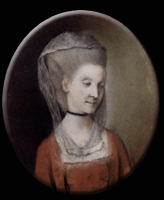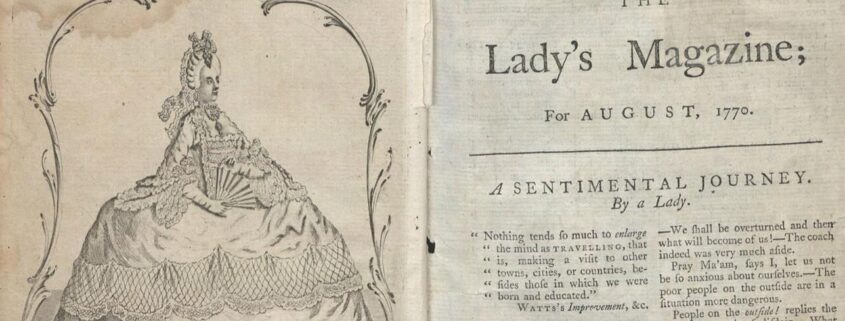A Quiet Revolution: Exploring 18th-Century Women’s Education through Sally Franklin and Polly Stevenson
The eighteenth century was a period of great change in many aspects, one of which was women’s education. The Enlightenment ignited the idea that men and women were created equal, though assigned to different responsibilities1. While women’s sphere of influence was still limited to mostly motherhood and domestic duties, there developed a greater sense of value of these roles, and the work women could do within these spheres expanded. The influence mothers had over their children, particularly sons, was seen as a powerful force, and so women began receiving a wider education to better train the next generation of leaders and statesmen2. Both Mary “Polly” Stevenson Hewson and Sarah “Sally” Franklin Bache carefully mastered challenging the status quo for women’s roles, all without ever causing a stir for leaving the female domain. Both women used their education to bring many traditionally-male duties into the feminine sphere and claim them as their own.
The typical education for a middle-to-upper class girl of the eighteenth century would encompass several disciplines, almost always taught at home by their mothers to prepare them for a life centred around the family and domestic duties3. Included in this curriculum was the traditionally feminine needlework, which was a practical skill as well as a beautifying one–it provided a way to demonstrate their refined tastes, but also meant that clothes could be mended instead of purchased new and served also as a means of income4. Polly was evidently a skilled knitter, as Franklin thanked her in a 1759 letter for a pair of garters, which he called “the finest, neatest and prettiest that were ever made!”5. Franklin was less complimentary of Sally’s work, though he often encouraged her to “spin & knit your Family Stockings,”6 frequently hoping she would contribute to the Franklin home’s domestic economy. Another key component of typical female education was reading, especially religious materials to perfect their moral development7. This was one of Franklin’s main focuses for Sally’s early education, writing to his wife that “I hope she continues to love going to Church, and would have her read over and over again the whole Duty of Man and the Lady’s Library”8. The Whole Duty of Man was an Anglican devotional book, and The Lady’s Library was probably an anthology of moral readings9; both works were likely meant to produce a Christian and feminine disposition. Both women may have also read women’s periodicals, such as The Lady’s Magazine, which covered secular subjects like fashion, romance, and education10.

Sally (1743-1808) was Franklin’s daughter. She stayed behind in the American colonies with her mother, Deborah, while Franklin was abroad in London for 16 years.
While Franklin certainly advocated for the components of a traditional female education for Sally in her teens, it seems that her studies may have had more of a radical start. In 1751, when Sally was eight years old, Deborah wrote a letter to Margaret Strahan ordering a set of books requested by Franklin to begin his daughter’s education. The curriculum included “1 Doz of Fomiliar Formes [sic.] Latin and Eng,” “1 Boyles Pliny,” and “6 Sets of Nature Displayd in 7 Volums [sic.],”11. These works prove that Sally was intended to learn Latin, philosophy, and some elements of biology, all of which were certainly not on the syllabus for the typical 18th-century girl, as these subjects were decidedly reserved for the male sphere. It does not seem, however, that the Franklins stuck to this revolutionary approach to Sally’s education, as by her early teens, there are no documented references to her study of any of these subjects. It seems instead that she diverted to the traditionally-female track of education, with studies of religion, French, and harpsichord12. It is unknown why her curriculum might have seen such a drastic shift, but it might have been due to Franklin’s frustrations with her progress. When Sally was thirteen years old, Franklin wrote to Deborah: “I should have read Sally’s French Letter with more Pleasure, but that I thought the French rather too good to be all her own Composing. I suppose her Master must have corrected it,”13. Franklin was evidently sceptical of his daughter’s abilities. Throughout Sally’s upbringing, Franklin seemed to be doubtful and critical towards her learning, often correcting her spelling or censuring her work ethic. He did, however, consistently encourage her to learn household accounting and arithmetic which, though intended for domestic use, were traditionally skills included in a male curriculum. It seemed that instead of an academic, Franklin saw Sally’s role as a future wife and mother, often reminding her to focus on these skills as “it is of the more Importance for you to think seriously of this, as you may have a Number of Children to educate”14.
While Sally embraced these domestic roles, marrying Richard Bache in 1767 and bearing eight children, she also used the practical skills acquired in her education to become a political activist. A patriot, Sally became a key member of the Ladies Association of Philadelphia, raising funds to support the American Revolution and organising an effort to sew over two-thousand shirts for soldiers at Valley Forge15. While for most of her life Sally, like most eighteenth-century women, was designated training to become a mistress of domestic duties, she pulled her skills of needlework, organisation, and management out of the home and used them in the male-dominated political world. Utilising the arts that society permitted to women, Sally’s tactic was not inflammatory or blatantly disruptive to the gender norms, but it allowed her to lead a quiet revolution by expanding feminine skills out of the home and into a politically-fraught war.
Polly Stevenson’s educational background before her introduction to Franklin at age eighteen is relatively unknown. Due to her situation in life and proficiency at writing and needlework, as evidenced through her letters to Franklin, it can be assumed that she had at least a similar traditional home education to Sally. Polly, unlike Franklin’s daughter, had great interest in academic subjects like philosophy, engineering, and natural science; in 1760, at age twenty-one, Polly asked Franklin to tutor her in these subjects in their correspondence. Franklin agreed, but questioned her motivation, asking, “but why will you, by the Cultivation of your Mind, make yourself still more amiable, and a more desirable Companion for a Man of Understanding, when you are determin’d, as I hear, to live Single?”16 As he did with Sally, Franklin saw a woman’s education as a training for life as a wife or mother, fearing that this extensive course of study had no purpose if Polly did not use it as a means to catch an academically-inclined husband.

Polly (1739-1795) was the daughter of Franklin’s landlady in London. She was like an adopted daughter to Franklin and corresponded with him for the rest of his life.
He later seemed to change his mind, admiring Polly’s scholastic aptitude and appreciation of learning: “After writing 6 Folio Pages of Philosophy to a young Girl, is it necessary to finish such a Letter with a Compliment? Is not such a Letter of itself a Compliment? Does it not say, she has a Mind thirsty after Knowledge, and capable of receiving it; and that the most agreable Things one can write to her are those that tend to the Improvement of her Understanding?”17 Polly led her course of study for the most part, with Franklin initiating only a brief survey of French philosophy18. Polly inquired about and studied entomology, geothermal heating, gravity, the tidal patterns of rivers, the distillation of salt water, the electrification of storm clouds, the polarisation of water molecules, and pathology.
Perhaps this final interest provided the connection with her later-husband, anatomist William Hewson. Polly wrote to Franklin, “I met with a very sensible Physician [Hewson] yesterday, who prescribes Abstinence for the Cure of Consumption. He must be clever because he thinks as we do”19. It is revealed in her second sentence that Polly views herself as a scientist of her own right, an equal to both Franklin and Hewson. Despite not being offered formal opportunities to train in science, by seeking out Franklin as a mentor, Polly created her own way of studying the subject in a way that would not upset the societal gender norms. Through her marriage to Hewson, she was able to bring the sciences into the household sphere; her husband opened a school of comparative and human anatomy at their 36 Craven Street home. While there exist no records proving Polly’s direct interaction with the school, it is difficult to believe that such an inquisitive and scientific mind would have never watched the operations or engaged with her husband’s theories on haematology when these many experiments took place under her own roof. Perhaps Polly used society’s prescription of marriage as a way to bring scientific study into her own sphere of access.
Franklin’s close involvement in supervising the education of both young women was highly unusual for the eighteenth-century, as the role was typically reserved for mothers to impart domestic skills on their daughters. While he still subscribed to the idea of Republican Motherhood–that their educations were a training only to be excellent wives and to educate their own sons one day–Franklin was a proponent of expanding the realm of education for women, as seen in his studying sciences with Polly and originally assigning Sally a curriculum of Latin and philosophy. Sally and Polly, however, were the opportunists who each saw a chance to challenge what they could do with their education. Sally brought her skills from the home into the male political sphere as an activist, and Polly brought the male scientific sphere into her home as the wife to a physician. Both women were able to cleverly subvert the societal prescriptions for women’s roles, by delicately merging the education of a homemaker with traditionally-male spheres.
By Emily Anne Harris
Footnotes
- Barker, Hannah, and Elaine Chalus. Women’s History : Britain, 1700-1850 : an Introduction. London: Routledge, 2005, p. 35.
- Ibid.
- Barker and Chalus, Women’s History, p. 40. .
- Barker and Chalus, Women’s History, p. 39. .
- Franklin, Benjamin. “1759.” Letter. Franklin Papers, Packard Humanities Institute, https://franklinpapers.org/framedNames.jsp (accessed 9 March 2023).
- Franklin, Benjamin. “March 16, 1780.” Letter. Franklin Papers, Packard Humanities Institute, https://franklinpapers.org/framedNames.jsp (accessed 9 March 2023).
- Barker and Chalus, Women’s History, p. 13.
- Franklin, Benjamin. “Feb 19, 1758.” Letter. Franklin Papers, Packard Humanities Institute, https://franklinpapers.org/framedNames.jsp (accessed 9 March 2023).
- Barker and Chalus, Women’s History, p. 13.
- Miller, Peter John. “Eighteenth-Century Periodicals for Women” p. 281. .
- Deborah, Franklin.“December 24, 1758.” Letter. Franklin Papers, Packard Humanities Institute, https://franklinpapers.org/framedNames.jsp (accessed 9 March 2023).
- Franklin, Benjamin. “February 19, 1758.” Letter. Franklin Papers, Packard Humanities Institute, https://franklinpapers.org/framedNames.jsp (accessed 9 March 2023)..
- Franklin, Benjamin. “November 22, 1757.” Letter. Franklin Papers, Packard Humanities Institute, https://franklinpapers.org/framedNames.jsp (accessed 9 March 2023).
- Franklin, Benjamin. “January 29, 1772.” Letter. Franklin Papers, Packard Humanities Institute, https://franklinpapers.org/framedNames.jsp (accessed 9 March 2023).
- “Sarah Bache,” Women of the American Revolution (American Revolution), accessed 9 March 2023, https://www.americanrevolution.org/women/women30.php..
- Franklin, Benjamin. “May 1, 1760.” Letter. Franklin Papers, Packard Humanities Institute, https://franklinpapers.org/framedNames.jsp (accessed 9 March 2023).
- Franklin, Benjamin. “September 13, 1760.” Letter. Franklin Papers, Packard Humanities Institute, https://franklinpapers.org/framedNames.jsp (accessed 9 March 2023).
- Franklin, Benjamin. “May 17, 1760.” Letter. Franklin Papers, Packard Humanities Institute, https://franklinpapers.org/framedNames.jsp (accessed 9 March 2023).
- Stevenson, Mary. “September 1, 1769.” Letter. Franklin Papers, Packard Humanities Institute, https://franklinpapers.org/framedNames.jsp (accessed 9 March 2023).


